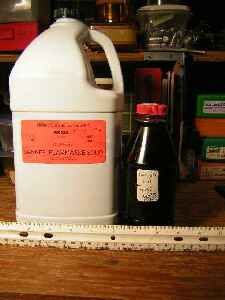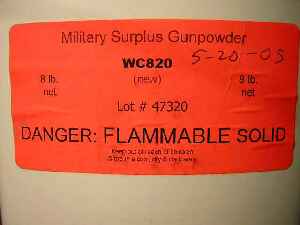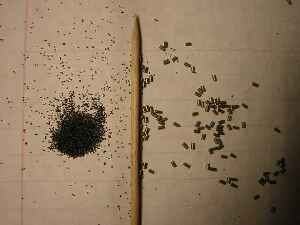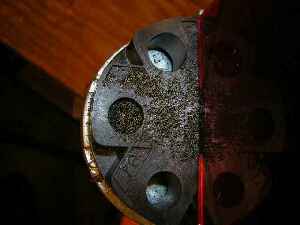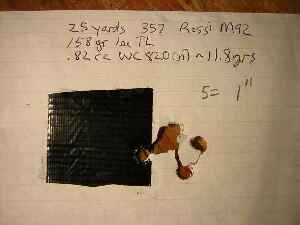|
Here in the backwoods of north Louisiana a pound of gunpowder costs about $25 including sales tax. After nearing the bottom of the can of Alliant 2400 powder I used for 357 mag rifle and 44 mag pistol, I started thinking about a cheaper, bulk replacement for it. Then I noticed guys on Internet forums talking about surplus powder WC820 working well in their 357 mag pistols and rifles. So I checked out the surplus powder for sale at www.gibrass.com They listed three versions of WC820:
I called gibrass.com at 1-800-714-6348 and ordered an 8 lb jug of WC820 (n). Adding shipping and a $20 per-order hazmat charge, it would come in my door at $11.75 per lb, a large savings. I snailmailed Jeff Bartlett at gibrass.com a copy of my driver's license and waited for the UPS man. While waiting, I went back to the forums and noticed guys getting good results with WC820 in 44 mag as well as 357 mag. As Jeff Bartlett was waiting for my driver's license copy to arrive before shipping my original order, I called him again and changed my order to two jugs of WC820 (n). While talking to Jeff, he informed me that WC820 was the same powder as AA#9 but from different lots. My WC820 (n) would load like a slightly faster burning AA#9. Exactly 7 days after placing my original order, the UPS man delivered me two 8 lb jugs, 16 lbs, of WC820 (n). With shipping + hazmat charge, it came in my door at exactly $159.68 or $9.98 per lb.
When the small bottle gets low, without opening the big jug's lid Here's a look at the label on the above 8 lb jug. The inscribed 5-20-05 is the date it came in my door. Both jugs were Lot # 47320. This shows the small bottle. It is clearly labeled as to its contents and is also labeled with its VMD of .0695 which I measured, as I do to all new powders, with a Lee 4.3cc dipper. For safety in case of fire, that red plastic lid will pop off easily.
NOTE: I live in a rural area with no fire code. Your local fire code may require you to store powder in its original container.
Probably because of the very small grains, WC820 (n) metered extremely uniformly with Lee dippers and in my Lee Auto Disk measure. I mean extremely. When checking VMD with a Lee 4.3cc dipper, 5 level dippers full weighed 309.1 grs. Just for the heck of it, I did it again. That 5 also weighed 309.1 grs. With Auto Disk cavity .82cc, for example, all of 5 charges weighed between 11.8 grs and 11.7 grs with most of them somewhere in between. The average was 11.76 grs. With cavity .88cc, all charges weighed between 12.9 grs and 12.8 grs with the average weight 12.82 grs.
After perhaps 300 loaded rounds I cleaned the powder off my bench. Just for the heck of it, I weighed that powder—30 grs or about 4¢. The weight also included some kernels of Varget, splinters of wood, and some brass shavings. So the cost of the leaked powder wasn't much of a factor. However, safety was a factor. So if you use an Auto Disk measure with WC820 (n) clean your bench frequently.
For reference purposes only, below see the dippers and cavities used in this test and the average amount of WC820 (n) thrown by each. NOTE: due to humidity differences alone, your results will vary!
The firearms used in this test and distances tested were:
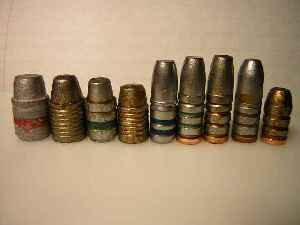 The cast bullets used in this test as you see them here and from left to right are (weights are average and include lube and gas check if used): The cast bullets used in this test as you see them here and from left to right are (weights are average and include lube and gas check if used):44 mag:
The testing (All tests used standard, non-magnum primers.) NOTE: all 25 yard groups were actually shot at 30 yards! 44 mag I began with 44 mag and used low AA#9 data. My intentions were to start low and to increase the size of the Auto Disk cavity in increments until high pressure revealed itself in the cases or high recoil revealed the wimp in me. Two facts are worth noting:
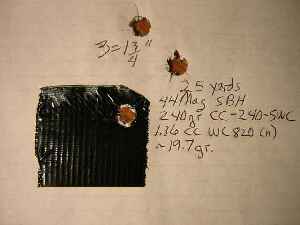 The results with a sample group on the right:
The results with a sample group on the right:Cases = R-P; primers = CCI Large Pistol.
Obviously, WC820 (n) works well in 44 mag pistol. From now on, my go-to 44 mag load is the 1.18cc Auto Disk cavity with WC820 (n) and the Custom Cast 240 gr SWC @ 1163 fps. Just for reference, I also shot one only 44 mag, 5 shot, 25 yard group with the Hornady 265 gr jacketed Flat Point and 1.18cc/17.4 grs WC820 (n). The results were: AV = 1118 fps; ES = 39; SD = 16; Group size = 3 1/8"
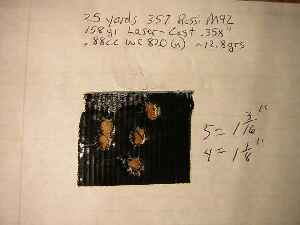 357 mag The 357 magnum rifle results were outstanding with WC820 (n). Over on the right see examples of groups with both the Laser-Cast and Lee bullets.
Like the 44 bullets, the 357 bullets went over the chronograph with almost identical data. So I combined the results. Again, I started low, but I stopped increasing the size of the Auto Disk cavity when velocities touched 1600 fps, which, I knew from experience, was the rifle's barrel leading point with non-gaschecked bullets.
Cases = R-P; primers = CCI Small Pistol. Again, best results came with just a slight crimp on the bullet.
The rifle is now zeroed dead-on as shown in the top group with the Laser-Cast bullet @ 1623 fps. That bullet, by the way, came in the door as 1,000 at a cost of about 6 ¢ per bullet. 30-30 Testing WC820 (n) in 30-30 rifle came about as the result of a forum guy mentioning he used 15 grs of it with 170 gr cast bullets in 30-30 for plinking loads. So I had to give it a try. The Lee 1.0cc dipper threw ~14.4 grs so I used it and shot one only 5 shot, 50 yard group with the ~170 gr bullets I had on hand. Cases = WW; primers = CCI Large Rifle BR.
I began with the Meister, which had previously given awful 50 yard or greater groups and great chronograph results. It remained true to form. The results with 1.0cc/14.4 grs WC820 (n): AV = 1640 fps; SD = 9; Group size = 16 1/4"
As expected, the Laser-Cast performed fine with both an added gas check and Lee Liquid Alox lube. The results with 1.0cc/14.4 grs WC820 (n): AV = 1638 fps; SD = 11; Group size = 2 5/8"
The Lyman 311041, a Custom Cast bullet with my Lee Liquid Alox and gas check added, did okay, too. The results with 1.0cc/14.4 grs WC820 (n): AV = 1620 fps; SD = 29: Group size = 2 7/8"
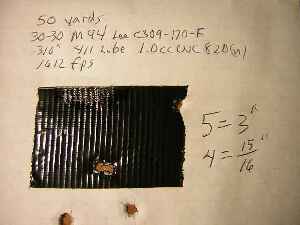 The Lee C309-170-F liked WC820 (n) as you can see from the photo on the right.
The Lee C309-170-F liked WC820 (n) as you can see from the photo on the right. The results with 1.0cc/14.4 grs WC820 (n): AV = 1612 fps; SD = 17; Group size = 5 in 3" & 4 in 15/16" To be fair, I must mention that the Lee C309-170-F bullets were indexed. Still, 4 in less than 1" at 50 yards is great, especially considering the fact that my target was in deep shade, and it was also taped to a sheet of newspaper which was suspended from the top and flapping in the breeze. I had to time each shot so the bullet hit the target when the sheet of newspaper was straight up and down—or thereabouts, anyway.
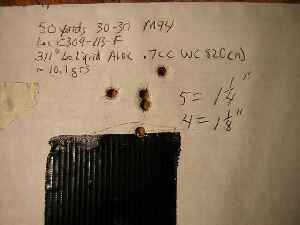 The shocker of all my testing was the Lee C309-113-F "soup can" bullet, it is called. I had previously wasted several days trying to get it to shoot using several different powders. Groups at 50 yards ran 6" to 12" and even more. All that little bullet needed to cure its ills was a dose of WC820 (n).
The shocker of all my testing was the Lee C309-113-F "soup can" bullet, it is called. I had previously wasted several days trying to get it to shoot using several different powders. Groups at 50 yards ran 6" to 12" and even more. All that little bullet needed to cure its ills was a dose of WC820 (n).I used a .7cc Lee dipper for ~10.1 gr WC820 (n). The photo on the right speaks for itself. The data: AV = 1480 fps; SD = 23; Group size = 5 in 1 1/4" That was with the target flapping in the breeze, too!
In conclusion, I can only say one thing: WC820 (n) works well. Hey, there's something else I can say—I wish I'd bought 3 jugs instead of 2. I'll run out in a couple of years, and there might not be any more. . . .
|
